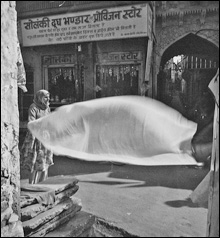|

STREET SEEN: An untitled image by Jonathan Sharlin.
|
By now we understand that photography does not hold a mirror up to life, that it is thoroughly subjective. But documentarians can toy with that notion, stressing as they do the objects that they examine through their lenses. In “4 Indias,” four photographers, three of them professionals, are celebrating the individuality of perception in an exhibition of images captured by them on the same trip.
The results range from flurries of street images to focuses on an interesting face or posed group here, an orderly composition of market goods there. The attempt wasn't to contrast and compare the same scenes, but to show differing sensibilities behind the cameras.
Two of the photographers shot this vibrant world in color, and the other two chose to quiet down the visual excitement by using black-and-white film. David H. Wells and Annu Palakunnathu Matthew are husband and wife, as are Jonathan Sharlin and Olivia B. McCullough.
As you might expect, the most visually compelling images tend to be those shot in color, which is such a prominent dimension of the India of saffron orange and cerulean blue. To allow spontaneity and quick reaction time, McCullough used a simple digital camera rather than a more professional but complex one. One of the especially striking images in the show she caught on-the-fly: the flamingo-pink blur of a sari as a woman passed by on a street. She also captured the welter by combining images: a woman extending a henna-decorated palm, above a study of two bare feet before lined-up sandals. Similarly, a landscape effect is accomplished by combining four horizontal photographs in the same print, whether presenting cows ranging freely on dirt streets or crowds of people eager to pose for a tourist lady's camera.
McCullough teaches photography at Roger Williams University and Northeastern University.
ADVERTISEMENT
 |
Also choosing color was David H. Wells, who has worked as a photojournalist in India, Asia, and South Africa. He is quite skilled at the journalist’s obligations to select and reveal telling details. From a crowd he notices a purple strap slashing across the naked back of a man; indoors he backlights the silhouette of a woman reaching down to a cradled baby. His compositions are carefully balanced to guide the eye. In one mysterious and beautiful photo, a dangling hand at the right anchors the frame as we see the outlines of men standing before a fluttering pink length of silk. Sometimes he subdues the busyness of an image in other ways: the color orange unifies and simplifies the photograph of a turbaned man sitting before draped garlands and a framed picture of a woman staring in the opposite direction.
The two photographers who restricted themselves to black-and-white did so with different intentions. Born in Britain and raised in Bangalore, Annu Palakunnathu Matthew has created a dreamlike world for us, where evocation and imagination predominate. She was using a cheap medium-format Holga camera, a toy with a plastic lens that softens images dramatically. The square images lend themselves to calming symmetry. With that effect, a billowing sheet obscuring the head of a standing figure seems ethereal rather than a mistake. A woman carrying a child steps along in fog — but whether toward or away from us we don't know. Sunlit images are clear enough in their details — a small figure in the middle distance might be dancing on flagstones, we don't know — but low light and slow shutter speed make for equally interesting accidental abstractions, with human figures identifiable but mystifying. Associate professor Matthew teaches photography at the University of Rhode Island.
Jonathan Sharlin is more comfortable with visual messiness, but he is skillful at minimizing any potential chaos through careful composition. A woman in white turning around to the photographer while a black rooster peering down at her is a study in stability, there at the center of shantytown clutter. As he stands amidst sari-clad mannequins and dangling child-sized puppets, we notice that a slouching shop proprietor is the only living figure. The photographer also likes to zoom in on patterns and textures: brass pots stacked gleaming in a shop; simple white decorations merging with dense elephant wrinkles. Sharlin is an educator and also well-experienced in documentary photography.
The “Four Indias” show is not only a reminder of the by-now obvious, that the world is in the eye of the beholder. It also demonstrates, quite interestingly, that every attentive and artful photographer contains a varied population of viewers within.
“Four Indias” | through June 18 | Newport Art Museum, 76 Bellevue Avenue, Newport